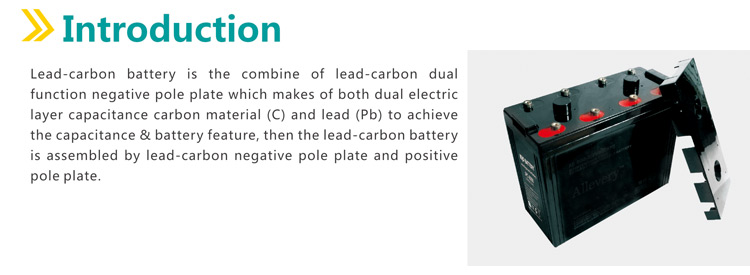Lead carbon batteries the king of energy storage industry
In recent years, with the increasing environmental pollution, all countries pay more and more attention to the development of clean energy and renewable energy. Energy storage, as an important technical support to improve the stability of renewable energy, also ushers in the future development. Currently the battery industry has the most potential for the development of lead-carbon batteries, liquid flow batteries and lithium batteries three energy storage technology batteries, but the higher the cost of liquid batteries, and technology maturity is far less than the other two battery technologies, and lithium-ion battery In the cell consistency there are some problems, therefore, insiders believe that lead-carbon batteries may become the most viable energy storage technology.
Lead-carbon battery is a traditional lead-acid batteries evolved from advanced technology batteries. The reason why it is called "advanced" is that lead-carbon batteries combine lead-acid batteries and supercapacitors into one, and maintain the advantages of high specific energy of lead-acid batteries in terms of the technology of utilizing supercapacitors for large-capacity charging in a short time, Thus has a good charge and discharge performance and long service life. In addition to the performance advantages, lead-carbon batteries are still in the cycle life, cost-effective, safety, low temperature performance, production and recycling processes have obvious advantages.
In recent years, lead-carbon battery technology has made considerable development, many domestic battery companies are also gradually improving the layout of lead-carbon batteries. Double Board Group is one of the early lead-carbon battery research and development companies. Since 2009, Shuangdeng Group has been continuously researching and adjusting materials, alloy formulations, grid structure and raw material ratio, and has developed lead-carbon energy storage battery products with high cycle life. At present, double-board lead-carbon storage battery has been used in IDC room backup power supply, wind power integrated storage station and other projects. In June 2014, Shengyang Co., Ltd. jointly developed lead-carbon battery technology with Furukawa in Japan. The number of cycles can reach 1.5 times that of lithium-ion batteries and more than twice that of ordinary lead-acid batteries. Sheng Yang shares the technology used in storage, backup power, communications base station power and other fields, and have a mass production capacity. The lead carbon battery developed by Narada Power has been used in many domestic energy storage demonstration projects. The good operation of these demonstration projects has once again verified the economy, stability and reliability of the lead-carbon battery system. The next phase, Narada Power will be in the field of new energy storage for commercialization of lead-carbon batteries, so that this has good market prospects for the real business technology to bring greater profits.
Although lead-carbon batteries have been rapidly developed in terms of technologies and applications, the performance of carbon materials is still one of the major factors that affect the overall performance of lead-carbon batteries. According to CAO Gao Ping, Ph.D., of the Research Institute of Chemical Defense, People's Liberation Army, the synergistic effect of porous carbon and lead active material in the negative plate of lead-carbon battery significantly improves the specific surface area and stability of the plate, thereby improving the cycle life and charge-discharge capacity of the battery. Therefore, the carbon material in the lead-carbon battery mechanism in-depth study, will further enhance the performance of lead-carbon batteries. In the future, in-depth research and application development of high-performance carbon materials will continue to be the focus of related research, which will further improve the performance of lead-carbon batteries and realize their large-scale application in the fields of energy storage and other fields.














